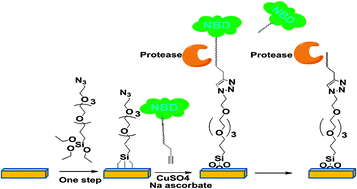A fluorescent amino acidprobe to monitor efficiency of peptideconjugation to glass surfaces for high density microarrays
Abstract
Using a fluorescent

* Corresponding authors
a
Department of Bioengineering and Center for Bioengineering Research, Bourns College of Engineering, University of California at Riverside, 900 University Avenue, Riverside, USA
E-mail:
jiayu.liao@ucr.edu
Fax: +1 951-827-6416
Tel: +1 951-827-6240
b Department of Chemistry and UCR Stem Cell Center, University of California at Riverside, 900 University Avenue, Riverside, USA
c Institute for Integrative Genome Biology, University of California at Riverside, 900 University Avenue, Riverside, USA
Using a fluorescent

 Please wait while we load your content...
Something went wrong. Try again?
Please wait while we load your content...
Something went wrong. Try again?
Y. Zhao, M. C. Pirrung and J. Liao, Mol. BioSyst., 2012, 8, 879 DOI: 10.1039/C2MB05471J
To request permission to reproduce material from this article, please go to the Copyright Clearance Center request page.
If you are an author contributing to an RSC publication, you do not need to request permission provided correct acknowledgement is given.
If you are the author of this article, you do not need to request permission to reproduce figures and diagrams provided correct acknowledgement is given. If you want to reproduce the whole article in a third-party publication (excluding your thesis/dissertation for which permission is not required) please go to the Copyright Clearance Center request page.
Read more about how to correctly acknowledge RSC content.
 Fetching data from CrossRef.
Fetching data from CrossRef.
This may take some time to load.
Loading related content
